-
Car Reviews
- All reviews
- Midsize SUVs
- Small cars
- Utes
- Small SUVs
- Large SUVs
- Large cars
- Sports SUVs
- Sports cars
- Vans
Latest reviews
- Car News
-
Car Comparisons
Latest comparisons
- Chasing Deals
After a slightly longer-than-expected wait, the new Mazda 3 Skayctiv-X has hit Australian shores – a familiar vehicle with a mechanical marvel under the bonnet. The first petrol-powered engine integrating diesel-like compression ignition to be produced at major scale, the Skyactiv-X is a mechanical marvel, which Mazda says is ready to deliver on its dual promises of reliably driving down real-world fuel consumption, and providing a more effortless driving experience by way of meatier low-end torque than a standard petrol engine. The 2020 Mazda 3 X20 arrives exclusively in high-grade Astina hatch or sedan form, in six-speed manual or automatic, priced at $40,590 or $41,590 respectively.
If you’ve never realised that the Mazda 3 needed these additional engine attributes – you’re not alone. Australia’s love affair with this popular Japanese small car began nearly 20 years ago – and aside from a passing dalliance with diesel options when fuel prices peaked in Australia at the turn of the 2010s, the Mazda 3 has been a mostly petrol-only affair in our market.
That said, since 2011 Mazda have rolled out a series of upgrades to their petrol engines, which involved boosting compression ratios for a leaner burn – and thus less fuel consumption – since the introduction of the novel SP20 model on the last of the second-generation cars. ‘Skyactiv’ tech then went range-wide for the previous third-gen shape.
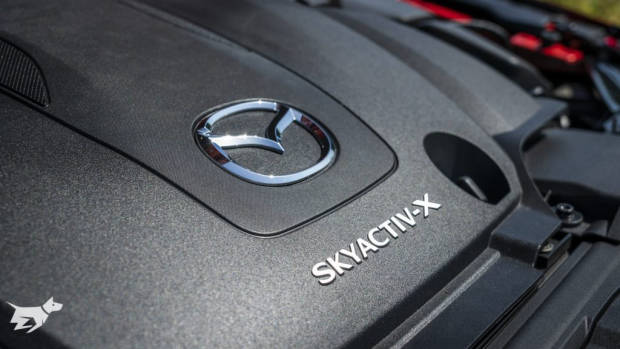
The complexity of those earlier efforts pale in comparison to the leap Mazda are making here. The first-stage Skyactiv engines that have served in various Mazdas for the last nine years saw compression ratios increased to 13:1 for Australia. Now, the Skyactiv-X sees that figure jump to greater than 16:1. It’s all part of a push for greater and greater efficiency. The world is warming up to electric motoring, but Mazda insist the combustion engine has much more to give.
The 2020 Mazda 3 X20 introduces this entirely new engine for Australia, though it’s already rolled out fairly widely in Europe on most Mazda 3 grades. The new motor, which initially measures two litres in displacement with four cylinders, though it can be made smaller and larger with ease, upends traditional combustion processes by using very high pressure to ignite the fuel at low or medium revs, like in a diesel engine. Spark ignition still happens – firstly, to trigger compression ignition – but only in earnest above the 5,000rpm mark, where the engine revs out in the style of a classical naturally aspirated petrol.
The Skyactiv-X engine uses a variety of novel solutions to achieve this combination, which is designed to drive in the order of a 20 to 30 percent improvement in real-world fuel consumption compared to a standard two-litre Mazda 3 G20. These include the employment of a small Roots-type supercharger on the front of the engine to force additional air into the engine, which helps the Skyactiv-X achieve a really lean air/fuel ratio of greater than 30:1 – about 14:1 is normal. Meanwhile, the compression ratio of this engine hits over 16:1.
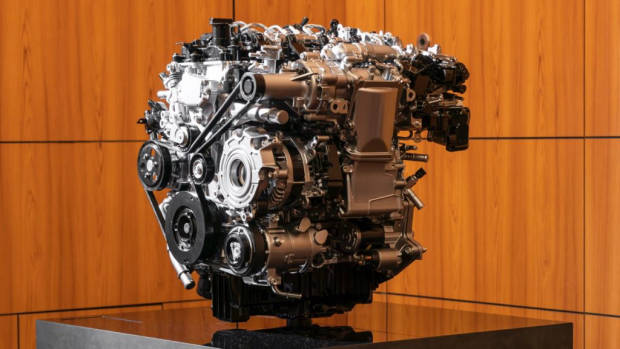
There’s also a separate 24-volt battery coupled to a mild hybrid system that utilises regenerative braking to operate a start-stop system that is genuinely near-imperceptible in the real world: as you’re coasting to a stop, the engine cuts out in a vibration-free manner and restarts much the same. However, unlike a Toyota Corolla Hybrid, the Mazda 3 Skyactiv-X never drives away on battery power alone. And while Mazda’s seventh-generation architecture that sits beneath this car can be adapted for electrification, as it has been in Mazda’s MX-30 electric SUV, the brand won’t say if they will strengthen the electric components of this engine in future.
We’ve covered a lot of the theory of the Skyactiv-X engine. What we’re even more interested in is whether the modicum of novel solutions adapted to this four-cylinder petrol generate positive results in the real world.
Producing 132kW of power at 6,000rpm and 224Nm of torque at 3,000rpm, this initial iteration of the Skyactiv-X engine isn’t intended to transform the Mazda 3 into a hot hatch – that’ll be up to the turbocharged 2.5-litre unit that is being shoehorned into this vehicle overseas, and which may come to Australia later.
Instead, Mazda suggests that the 132kW/224Nm X20 engine splits the difference between offering perky performance and good economy. That’s more or less how it feels on the road. This engine offers a really good blend of available low-down torque before seamlessly transforming into the kind of rev-happy engine as you rev the two-litre through about the 5,000rpm level.
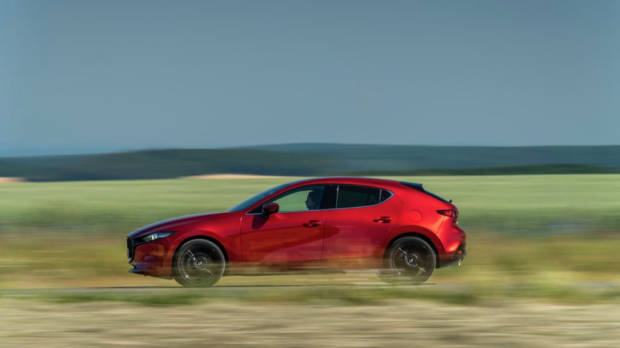
When accelerating off the line or when building speed if you’re already moving – everything but full-throttle work, basically – the Mazda 3 X20 utilises compression ignition. We know this not from any diesel-like vibration, which is entirely missing here, because you can watch the combustion process on a graphic on the central 8-inch display. Bury the pedal – or alternatively shift down – and rev to the sky and the engine switches imperceptibly to conventional spark ignition. On paper and in the real world, this engine starts to feel like the best of both worlds.
It’s the high-revving character where the Skyactiv-X outdoes the now de rigeur turbocharged engines in the small car segment in Australia, which serve up even meatier torque than this Mazda, but tend to run out of puff well before they hit their marked redlines. In a Volkswagen Golf or Ford Focus, the automatic prioritises short-shifting to keep the engine at low revs.
The 1.4-litre turbocharged Volkswagen Golf, for example, produces a stronger 250Nm of torque at just 1,500rpm – so its seven-speed dual-clutch automatic gearbox works to keep the engine near this engine speed to keep the Golf ‘on the boil’.
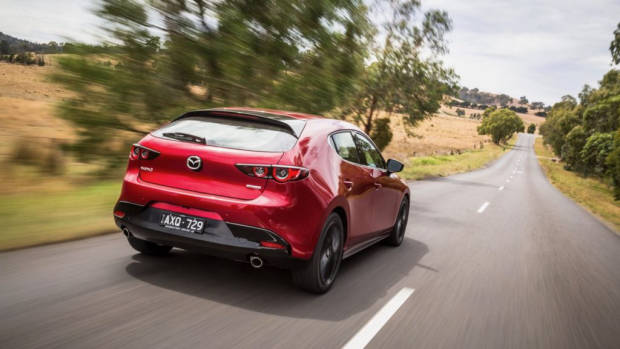
By contrast, the six-speed torque converter (or six-sped manual) Mazda 3 shifts less as the super-lean compression ignition cycle relies on more air and less fuel, making the engine feel less restrained but also a little less flexible. There’s no way to avoid the fact that the Skyactiv-X produces lower (224Nm) of torque at higher revs than its turbo rivals, so it does need to be worked a little harder.
Buyers who prefer the simplicity of a conventional auto or manual will appreciate the fact that this car avoids the complexities of a double-clutch gearbox or the need for a turbocharger.
The rest of the Skyactiv-X driving experience is essentially a mirror of the near-identical G25 Astina grade. That means the Mazda 3 X20 enjoys safe, secure, and sporty handling, with particularly feelsome steering. This is a car that makes you want to seek out a great country road: you can tell the same people work on the MX-5 as the Mazda 3.
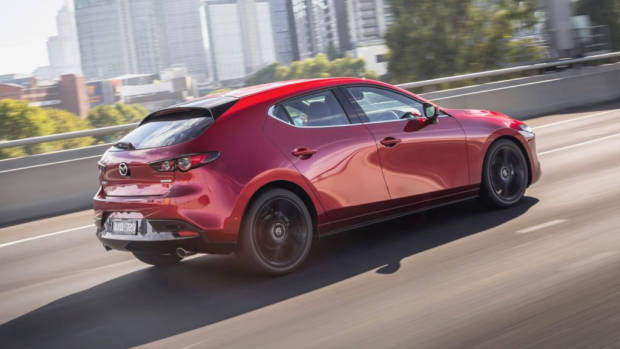
However, it’s not all rosy, dynamically-speaking. We’ve consistently felt that the new Mazda 3 hatchback’s front suspension is way too stiff, juddering over Sydney’s uneven road surfaces in a manner that is at times uncouth. The sedan is a bit softer in the front end and seems to mostly solve this problem.
Both Mazda 3 body styles – hatch and sedan – are remarkably quiet on the road, with excellent levels of sound insulation making them feel quite luxurious while cruising, allowing you to make the best of the cracking twelve-speaker Bose audio system.
Impressively, despite needing to be revved a little higher than turbocharged rivals, the Mazda 3 Skyactiv-X manages to basically match the likes of the Golf and Focus for real-world fuel economy when driven normally – and the Mazda is actually more economical when driven very hard. That said, the Skyactiv-X doesn’t quite live up to the promise of diesel-like economy in a petrol-powered vehicle.
We managed about 5.5L/100km on the highway and about 7L/100km in stop-start town traffic – combine the two in a normal pattern of driving and you’ll see figures in the mid- to high-sixes. That wasn’t driving particularly carefully or economically, nor driving the vehicle hard. It’s a realistic set of numbers.
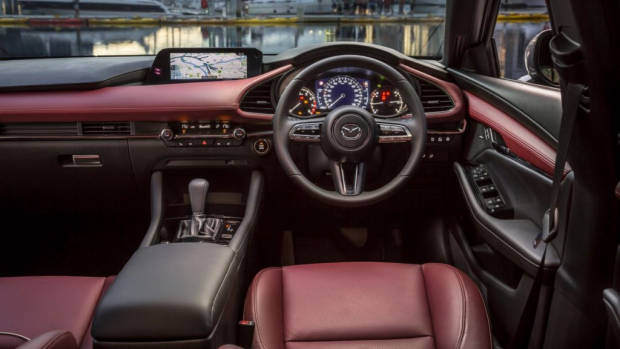
That means the Skyactiv-X engine makes it easy to reduce your real-world fuel consumption when compared to the standard Mazda 3 2.5-litre, which uses about 6L/100km on the highway and about 8L/100km in town.
However, those improvements don’t really add up to an economic argument in favour of purchasing the Skyactiv-X. Like any brand new technology, Mazda needs to recoup high levels of research and development spending, so initially, buying the X20 engine seems pretty expensive.
At launch, the new Skyactiv-X engine is only available in the highest specification of the Mazda 3, which is badged Astina. The X20 Astina costs $40,590 as a manual (about $45,000 driveaway), or $41,590 with an automatic (about $46,000 driveaway).
Over and above the regular G25 Astina model, which utilises a 140kW/250Nm 2.5-litre naturally aspirated ‘non-X’ engine, the Skyactiv-X costs $3,350 more, but carries the same set of features. The differences are all in the engine and mild hybrid system.
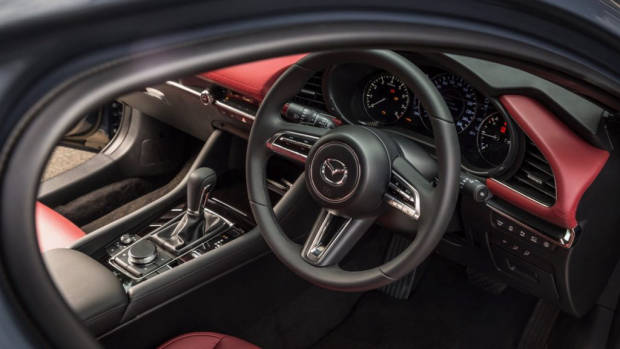
It does mean that the X20 Astina gets all the best Mazda 3 features as standard. Outside, you’ll recognise an Astina by its 18-inch wheels (black on the hatch, silver on the sedan). There’s also automatic adaptive LED headlights, a sunroof, and reverse tilt-down auto-folding mirrors. Inside, the seating is leather (black or burgundy for the hatch, black or white for the sedan), with heating for the front seats and steering wheel. The driver enjoys a 10-way power adjustable seat with two-position memory that is also linked to the mirrors.
Tech-wise, the Astina grade carries the same 8.8-inch widescreen Mazda Connect display as all Mazda 3s, with navigation, DAB radio, wired Apple CarPlay, and wired Android Auto. You also get a 12-speaker Bose stereo, a seven-inch digital driver display, paddle shifters, and full keyless entry and start. Rear seat passengers will appreciate the second-row air vents and flip-down armrest.
Safety-wise, Astina variants get all the fruit, including a full autonomous emergency braking including in reverse gear, a 360-degree parking camera, radar cruise control, lane keep assist, rear cross traffic alert, blind spot monitoring, and driver fatigue detection.
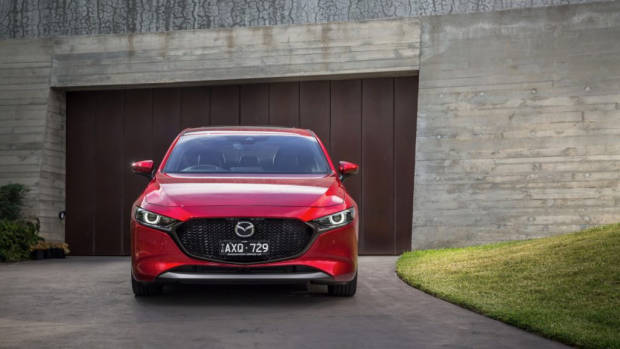
There is also traffic sign recognition, and Cruising and Traffic Support, which lends the Mazda 3 low-speed semi-autonomous driving capabilities. You also get front and rear parking sensors.
Of course, if you’re not all that interested in the mechanical element to this new engine, all the same goodies are available on the standard G25 Astina, which is priced at $37,240 for the manual (about $42,000 driveaway), or $38,240 for the automatic (about $43,000 driveaway).
That’s really up to you. If you’re the kind of person that loves to be on the cutting edge of technology, loves the look of the new Mazda 3 and also wants to do their bit to cut fuel use and help our environment, then your worlds might all align in the 2020 Mazda 3 X20 Astina.
There is no getting around the fact that, at launch, the Skyactiv-X powertrain is expensive and beyond most people’s budget when shopping for a mainstream small vehicle. Thankfully for Mazda, the new 3 is so good that it can pretty much carry off near-luxury pricing.
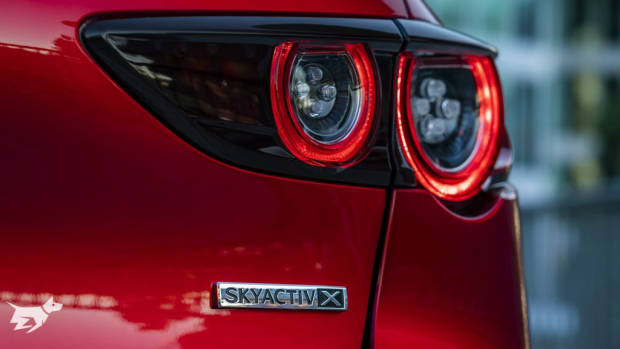
The biggest problem for the X20 is that you can get all the same equipment with a more conventional petrol engine. That said, with a ballpark take-rate of 2 or 3 per cent on the X20, this car’s niche status won’t be upsetting anybody.
Certainly, we’d recommend sampling both the G25 petrol and the X20 Skyactiv-X petrol if you are looking into a Mazda 3 Astina – if only to try out this substantial leap in combustion engine technology – and congratulations to Mazda on pushing innovation forward in this segment.
Key specs (as tested)
About Chasing cars
Chasing Cars reviews are 100% independent.
Because we are powered by Budget Direct Insurance, we don’t receive advertising or sales revenue from car manufacturers.
We’re truly independent – giving you Australia’s best car reviews.
The estimate provided does not take into account your personal circumstances but is intended to give a general indication of the cost of insurance, in order to obtain a complete quote, please visit www.budgetdirect.com.au. Estimate includes 15%^ online discount.
^Conditions Apply
Budget Direct Insurance arranged by Auto & General Services Pty Ltd ACN 003 617 909(AGS) AFSL 241 411, for and on behalf of the insurer, Auto & General Insurance Company Limited(ABN 42 111 586 353, AFSL 285 571).Because we don’t know your financial needs, we can’t advise you if this insurance will suit you. You should consider your needs and the Product Disclosure Statement before making a decision to buy insurance. Terms and conditions apply.
Indicative quote based on assumptions including postcode , 40 year old male with no offences, licence suspensions or claims in the last 5 years, a NCD Rating 1 and no younger drivers listed. White car, driven up to 10,000kms a year, unfinanced, with no modifications, factory options and/or non-standard accessories, private use only and garaged at night.
^Online Discounts Terms & Conditions
1. Discounts apply to the premium paid for a new Budget Direct Gold Comprehensive Car Insurance, Third Party Property Only or Third Party Property, Fire & Theft Insurance policy initiated online on or after 29 March 2017. Discounts do not apply to optional Roadside Assistance.
2. Discounts do not apply to any renewal offer of insurance.
3. Discounts only apply to the insurance portion of the premium. Discounts are applied before government charges, taxes, levies and fees, including instalment processing fees (as applicable). The full extent of discounts may therefore be impacted.
4. We reserve the right to change the offer without notice.